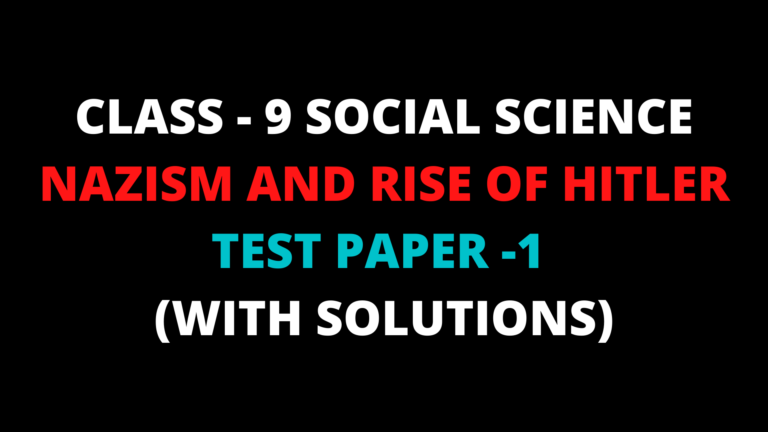General Instruction:
All Questions are Compulsory.
Question No. 1 to 4 carries one mark each.
Question No. 5 and 10 carry three marks each.
Question No. 11 and 12 carry five marks each.
- Name the secret police of German.
- Name the Nazi youth group for children below 14 years of age.
- What is the name of German Parliament?
- What was the name of the treaty signed between Allies and the Weimar Republic?
- Who bailed Germany out from the situation of ‘hyperinflation’ and how?
- First World War left a deep imprint on European society and polity. Support the
statement with three examples. - Explain any three reasons that led to the German invasion of Soviet Union.
- State the reasons responsible for the USA to join the Second World War.
- Highlight any three important circumstances under which Hitler came to power.
- Describe the Battle of Stalingrad in Second World War?
- Highlight the important features of the education imparted in Nazi Schools.
- Highlight the different provisions which were made by Nazis for German Youth to enter
the Nazi organizations.
CBSE TEST PAPER-02
Class –IX Social Science (Nazism and Rise of Hitler)
[ANSWERS]
1. Gestapo
2. Jungvolk
3. Reichstag is the name of German Parliament.
4. Versailles Treaty
5) a) The Americans intervened and bailed Germany out of the crises.
b) America introduced the Dawes plan.The Dawes Plan of 1924 was formulated to take
Weimar Germany out of hyperinflation and to return Weimar’s economy to some
form of stability.
c) This plan reworked the terms of reparation to ease the financial burden on Germans.
6. a) Soldiers came to be placed above civilians.
b) Politicians and publicists laid great stress on the need for men to be aggressive, strong
and masculine.
c) Those who supported the Weimar Republic became easy targets of attack in the
conservative national circles.
d) Democracy was a young idea which could not survive the instabilities of interwar
Europe.
7) a). Germany attacked the Soviet Union as it was part of their policy of expansionism. By
attacking the Soviet Union, Nazis wanted to establish control over Eastern Europe.
b) Also to ensure space and regular food supplies for the Germans from that front.
c) However, it was one of the greatest military blunders made by Germany has been
attacking the Soviet Union in 1941. This was considered to be the historic blunder and
biggest mistake as it exposed German’s western front to aerial bombardments from
Britain and its western front to the Soviet red army.
8) a) Japan was expanding its power in the east.
b) It had occupied French Indo-China was planning attacks on US naval bases in the
Pacific.
c) When Japan extended its support to Hitler and bombed the US base at Pearl Harbor,
the US entered the Second World War.
9) a) Hitler was an extraordinary speaker and had the ability to convince people that he
could bring them out of their misery.
b) The 1920s was a period of extreme economic hardship for Germany and they could
believe anyone who could be that convincing.
c) The German people were disoriented by the World War – I as they could never
imagine Germany losing.
d) They badly sought answers for the defeat and one young lad convinced them that he
had the answers.
e) Hitler got the time to build his Nazi ideas and built a strong following. People started
to believe in him and he got the reputation of a person who could make a great
sacrifice for Germany.
10) a) The Battle of Stalingrad was one of the largest and deadliest battles in World War II. It
was a turning point in the war.
b) The battle began with the German air force, the Luftwaffe, bombing the Volga River
and the then the city of Stalingrad. They reduced much of the city to rubble.
c) The battle took place during the last part of 1942 & early 1943. After months of
fighting & finally nearly starving to death, Germans surrendered on February 2, 1943.
11) a) Good German children were subjected to a process of Nazi schooling, a prolonged
period of ideological training.
b) School textbooks were rewritten to justify Nazi ideas of race.
c) Stereotypes about Jews were popularized even through mathematics classes. Children
were taught to be loyal and submissive, hate Jews and worship Hitler.
d) Even the aim of sports was to nurture a spirit of violence & aggression among
children.
e) Hitler believed that boxing could make children iron hearted strong and masculine.
12) a) Youth organizations were made responsible for educating German youth in the spirit
of National Socialism.
b) Ten-year-olds had to enter Jungvolk. At 14 all boys had to join the Nazi youth
organization-Hitler Youth-where they learned to worship war, glorify aggression and
violence, condemn democracy, and hate Jews, communists, Gypsies and all those
categorized as undesirable.
c) After a period of rigorous ideology and physical training, they joined the labour
Service, usually at the age of 18.
d) Then they had to serve in the armed forces and enter one of the Nazi organizations



